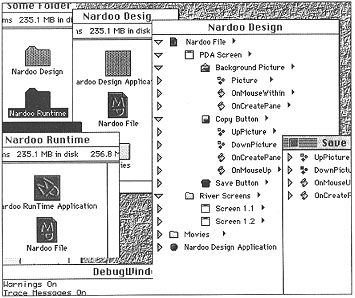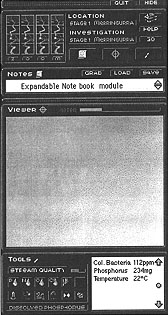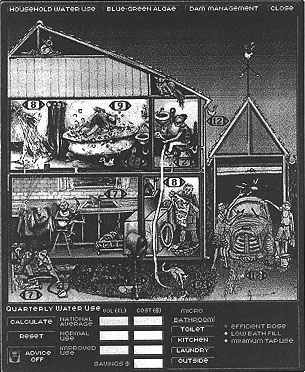[ IIMS 96 contents ]
Metaphors for authoring interactive multimedia
John Hedberg, Barry Harper, Robert Wright and Grant Farr
University of Wollongong
With the introduction of interactive multimedia learning materials and the movement towards constructivism as an underpinning philosophy for the design of democratic learning environments, the organising metaphor of the authoring system has become critical in the effective design of the final learning environment. There is a need for easy to use development tools which incorporate alternative metaphors in the development process. There exist a multitude of authoring tools such as Authorware Professional, ToolBook, Spinnaker Plus, Director and HyperCard, these are examined for the limits to their applicability in providing access to information structures and the instructional strategies available to the learner as they move through and create new knowledge constructs within these environments. In this paper, a new tool for authoring "MediaPlant" which has its roots in constructivist thinking is examined as an alternative authoring environment. This package is unique in that it allows multiple levels of representation of the component information; it supports the designer by enabling the unit of analysis to be an object, a screen or an integrated information element which might include multiple screens but with a unified information structure. Exploring the Nardoo, a product developed with this tool, will be demonstrated.
Introduction
The development of educational software has always sought to employ in its short history a number of authoring environments that enable instructional technologists rather than programmers to design and develop applications. The major advantage of these tools has been that the designer did not need to hold computing skills in high level languages, rather they could use a simpler instruction set and pre-programmed modules or strategies. The major disadvantages were that the developer was limited to the pre-programmed modules available, with their attendant assumptions about the underlying instructional strategy and that such applications mostly run as interpreted rather compiled applications leading to poor response and constrained performance especially on low end hardware.
With the introduction of interactive multimedia formats, and the perceived need for easy to use development tools, a multitude of authoring tools such as Authorware Professional, ToolBook, Oracle Media Objects, Macromind Director, Digital Chisel and HyperCard have been developed. Many of these packages have a constraining model of how they present information and manage interactions. Simply stated, it is instructive to consider the models that each is best suited to provide for both the developer and the user of the final package. A further complication is that many of the tools do not allow cross platform development and the speed of the resulting instructional packages is always going to be limited by the interpretive layer.
Consider the underlying metaphor for some of these tools.
- Authorware uses a two screen display of structure and presentation, the structure is represented as a flow chart and the essential model is that an element is presented and the responses is entered and judged for an action. The structure of each project is essentially a view of the world as a flow chart within flow chart or one component flow chart moves to another component flow chart.
- Director uses the multiple window environment in which resources are created or managed onto an operatic metaphor of a stage. 'Me management is through a time dependent score which allows objects to be treated as members of the opera company and moved through time and backwards and forwards from backstage to front stage.
- HyperCard, Oracle Media Objects both employ a screen based metaphor, onto which objects are placed and under each is some script which dictates what will happen if that object is selected clicked or moved in some way. While these tools have an immediacy they lack the overall structure representations of the previous two.
- Digital Chisel and Hyperstudio add further constraints to the screen based metaphor of HyperCard and provide a highly structured set of interactions, all preset and limited in their complexity of response. However, like Authorware, they include an instructional management system as an automatic feature of the package.
MediaPlant as an authoring environment
With the current demand for cross platform applications and the need to have high performance, in terms of speed and features, the Interactive Multimedia Learning Laboratory team, at the University of Wollongong, set out to develop a software development environment that would satisfy these needs and also not constrain the instructional design models used. It was envisaged that the development environment would facilitate the production of complex learning environments, ie this would be an authoring tool that offered complete flexibility in the design process and also high level performance on entry level machines that could be compiled into a runtime application.
The key elements of the authoring environment are that the tool includes
- rapid prototyping of design ideas and restructuring of ideas simply and efficiently.
- design elements that can be added through either menu selection or copy and paste facilities
- design elements that can be edited, reused, and repurposed simply and efficiently
- hypertext linking from element to element
- extensibility so that new features can be added when necessary
- visual representation of the application and the authoring environment available at all times.
The authoring environment consists of a development program and a runtime program. The development program is used to construct and test the product, and this is then compiled as a runtime version. The development program is Macintosh based with runtime packages being developed for either platform. The software environment is based on a C++ application framework tailored for large scale multimedia development.
The memory requirements for MediaPlant are 8-10 MB for the development program (the more the better) and approximately 2 MB for the runtime application. The runtime application memory allocation with depend on a number of factors with the basic break up of the following form.
The runtime application
code, resources, internal data structure (including cache) - 1 MB
Image resources loaded typically consisting of
a screen image (300 kB for full screen)
off screen buffer (300 kB for full screen)
buttons (50 kB)
additional pictures (150 kB)
Total approximately 2 Megabytes
Because of the memory management built into MediaPlant, the runtime applications will run in less memory, but there will be a speed overhead. Applications can also use more memory by holding more media elements in memory if it is available.
The development program metaphor is based upon a tree file structure with pull down menus for the authoring process. A graphic design interface has not been developed for this stage of the environment development. The file structure metaphor, has a drag and drop and editing widow facility for each element. The structure is completely versatile in that each element below the container level is named either with a presumed location, which is its tree structure location, or can be given a prefix file location. This structure has a number of advantages in that it allows multiple use of resources, allows the developer to manage the data elements in whichever way best suites their preferred design style and with use of the 'drop and drag facility' allows easy and rapid rearrangement of the data elements.

Figure 1: A tree file structure used in MediaPlant with pull down menus for the authoring process
Exploring the Nardoo and problem solving
A new package developed using this authoring tool, based on ecology, called Exploring the Nardoo incorporates problems that challenge students to become active participants in the learning process. Exploring the Nardoo provides the student with a flexible set of tools made available through a personal digital assistant (PDA), Figure 2, to assist in the problem solving process.

Figure 2: The Personal Digital Assistant Notebook
The process of using source material within the package in support of an investigation has been enhanced to allow the student to:
- Decide precisely on the quantity and selection of text to be copied into their notes. This is either through making a selection and then 'grabbing' it into the PDA or by using a 'drag and drop' technique where the target text is selected or highlighted and 'dragged' into the notes module of the PDA.
- Use marker buttons as pointers to video, audio or picture information which can be displayed within the PDA's viewer along with any linked information. For example, by copying a picture of a wombat into their notes, the student is able to move throughout the information landscape within the package and very quickly view the picture of the wombat as well as its associated text within the PDA's viewer merely by clicking on the marker button within their notes. User defined portions of the reference text material displayed within the viewer is able to be selected and copied into the notes also.
- Gather video material, place 'in' and 'out' point markers within it and display it within the PDA thus increasing the student's ability to be more selective in what they choose to use in response to an investigation.
- Manipulate marker buttons and text within the notes areas, via 'drag and drop', to facilitate the reordering of ideas in the process of building an investigative response in the form of a report, explanation, procedure etc.
- Use text style tools, within editable text notes, providing the opportunity to use font colour, style and size as organising criteria within the notes. For example a student may recognise that a certain combination of text attributes is representative of newspaper clippings or they may choose to colour information they write or gather from a particular perspective in a special colour.
The joint combination of note book and viewer better equips students to view and then critically evaluate or compare different representations of the sum information concept. By collecting different media representations of the same topic and 'flipping' between these representations at their discretion, the student has the opportunity to establish cognitive links between different media forms which compliment each other and support a central theme or information focus.
The package also provides the ability to record thoughts and impressions 'on the fly' whilst examining media stories. This provides the potential for students to reorganise or revise their thoughts to better 'make sense ' of what they see and hear. Students are able to document their emerging ideas in support of an investigation or problem solving exercise whilst viewing different media. This provides support in the formulation of new schemata in the process of accommodating the new information.
By way of illustration, whilst viewing a video segment related to the issue of water conservation, students may have their attention drawn to a specific aspect such as better ways to manage water use within the household. The Nardoo PDA provides the means by which they are able to search out other related information (text, graphics, radio/television reports) and store it within their notes 'alongside' previously captured information. The different perspective's represented within the source media items can be viewed, edited and brought into context within the student's framework of notes they are making. They can, in addition, model water user using one of the three simulators built in. (Figure 3.)

Figure 3: A personal water use simulator
To facilitate the re-ordering or re-prioritising of information Nardoo provides a separate, expanded form of the notebook. This device has been termed a 'text tablet'. It provides the editing facilities offered by the PDA as well as other features to assist with the restructuring of notes into a form more suited to small group presentation or a particular genre style. The text tablet provides a larger expanse of editable screen/document space into which student notes may be copied to/from the PDA notes module.
A writing genre template (discussed in the following section) can also be loaded directly into the text tablet into which portions of the student's notes may be copied or dragged. Notes from prior sessions can be loaded into the text tablet and used in support of current investigations. Being able to store and report thoughts and impressions derived from media experiences by using the media itself (actual video/audio and pictures not just text representations of the media) provides a more powerful means of reformulating ideas (Kenny and Schroeder, 1994, p 965).
The multimedia collection, editing and presentation facilities offered within Exploring the Nardoo are extensive and present a great potential for students to become manipulators of multiple media. New avenues are opened for expression for those who choose to use the facilities within the package. We are aware however, as Kenny and Schroeder (1994) point out "learner's not accustomed to this technique and multimedia facilities will require instruction in its use" before they become proficient with the technique but once accustomed to it the student has a powerful process at their disposal to gather, organise and illustrate their ideas. Support for teachers and students in the use of these features will be modelled through walk through movies made available through the help system and also detailed in support notes available in reference books within the package.
Conclusion
MediaPlant is a powerful new authoring tool based on a constructivist framework. A package developed using this tool, Exploring the Nardoo provides a supportive notebook to allow students to collect and report their investigation based on problem solving techniques. The support tools allow multimedia reporting and are supplemented by several metacognitive tools for the writing process. These tools not only include details about genre but also templates to support the learners. The major focus is upon the ways in which students can manipulate the tools and also extend common concepts such as copy and paste into other forms of representation of information. The authoring tool will now be developed to include a graphic user interface, for the instructional designers, that supports a variety of design models.
Reference
Kenny, R. and Schroeder, E. (1994). The integration of learning strategies in interactive multimedia instruction. Paper presented at the AECT National Convention and INCITE'94 International Exposition, Nashville, TN February, 961-979.
Authors: John Hedberg, Barry Harper, Robert Wright and Grant Farr
Interactive Multimedia Development Laboratory
Faculty of Education, University of Wollongong
Wollongong NSW 2522
Email: J.Hedberg@uow.edu.au
Please cite as: Hedberg, J., Harper, B., Wright, R. and Farr, G. (1996). Metaphors for authoring interactive multimedia. In C. McBeath and R. Atkinson (Eds), Proceedings of the Third International Interactive Multimedia Symposium, 16-21. Perth, Western Australia, 21-25 January. Promaco Conventions.
http://www.aset.org.au/confs/iims/1996/ek/hedberg1.html
|
[ IIMS 96 contents ]
[ IIMS Main ]
[ ASET home ]
This URL: http://www.aset.org.au/confs/iims/1996/ek/hedberg1.html
© 1996 Promaco Conventions. Reproduced by permission. Last revision: 14 Jan 2004. Editor: Roger Atkinson
Previous URL 20 Nov 2000 to 30 Sep 2002: http://cleo.murdoch.edu.au/gen/aset/confs/iims/96/ek/hedberg1.html




